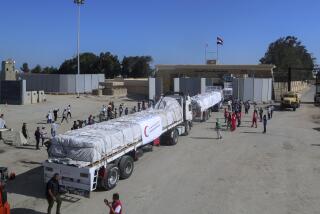The handouts that feed poverty
FOREIGN AID today perpetrates a cruel hoax on those who wish the world’s poor well. There is all the appearance of energetic action -- a doubling of foreign aid to Africa promised at the G-8 summit last July, grand United Nations and World Bank plans to cut world poverty in half by 2015 and visionary statements about prosperity and democracy by George W. Bush, Tony Blair and Bono. The economist Jeffrey Sachs even announced the “end of poverty” altogether by 2025, which he says will be “much easier than it appears.”
No doubt such promises satisfy the urgent desires of altruistic people in rich countries that something be done to alleviate the grinding misery of the billions who live in poverty around the world. Alas, upon closer inspection, it turns out to be one big Potemkin village. These grandiose but unreal visions sadly crowd out better alternatives to give real help to real poor people.
The new proposals to end world poverty are, for one thing, not new. They are recycled ideas from earlier decades that have already failed. There was, for instance, the idea of the 1950s and 1960s that aid is necessary to finance a “Big Push” to allow poor countries to escape a “poverty trap” and climb the ladder toward prosperity.
This push has been underway for four decades now -- and has resulted in the movement of $568 billion in foreign aid from the rich countries to Africa. The result: zero growth in per capita income, leaving Africa in the same abysmal straits in which it began. Meanwhile, a number of poor countries that got next to no aid had no trouble escaping the “poverty trap.”
Hence, it is a little surprising to see Sachs, who is director of the Earth Institute at Columbia University and an influential advisor to U.N. Secretary-General Kofi Annan, announcing once again that aid is necessary to finance a “Big Push” to allow poor countries to escape a “poverty trap” and climb the ladder toward prosperity.
Where did all the aid money go? The $2.3 trillion, that is, that has been sent to all the world’s poor countries over the last five decades. Well, for one thing, it was stuck (and remains stuck) in a “bureaucracy-to-bureaucracy” aid model in which money gets lost all along the way.
The way it works is that a large aid bureaucracy such as the World Bank (with its 10,000 employees) or the United Nations designs a complicated bureaucratic plan to try to solve all the problems of the poor at once (for example, the U.N. Millennium Project announced last year laid out 449 steps that had to be implemented to end world poverty). The aid money is then turned over to another bureaucracy in the poor country, which is asked to implement the complicated plan drawn up by out-of-country Westerners. (How complicated? Tanzania -- and it’s not an unusual case -- is required to issue 2,400 different reports annually to aid donors.)
In the best case, the bureaucracy in the poor country is desperately short of skilled administrators to implement complex top-down plans that are not feasible anyway -- and report on their failure to do so. In the worst, but all too common, case -- such as that of the corrupt dictator Paul Biya of Cameroon, who will get 55% of his government revenue from aid after the doubling of aid to Africa -- the poor country’s bureaucrats are corrupt or unmotivated political appointees.
It shouldn’t be too surprising, then, that aid money doesn’t reach the poor and instead goes to such dubious projects as the $5-billion Ajaokuta steel mill in Nigeria, which was begun in 1979 and has yet to produce a bar of steel (thanks to the corruption and incompetence of local bureaucrats).
Nor is it surprising that the poor of Cambodia have trouble benefiting from aid-financed education when corrupt schoolteachers “supplement their income by soliciting bribes from students, including the sale of examination questions and answers.” (The quote comes from the U.N. Millennium Project, which nevertheless concluded that corruption was not a significant hindrance to aid).
A new initiative by Sachs calls for aid-financed “Millennium Villages” (moving the Potemkin village out of the realm of metaphor into reality.) It envisions a whole package of quick fixes, ranging widely from fertilizer, grain storage, rainwater harvesting and windmills to Internet connections -- which would, supposedly, alleviate poverty in a handful of specifically targeted rural villages around Africa.
This much-trumpeted idea once again shows the amazing recycling ability of the aid industry -- because a similar package of fixes called “Integrated Rural Development” was already tried in the 1970s (minus the Internet connections). It failed.
Flying in foreign experts to create a miniature village utopia has little to do with the complex roots of poverty, such as corrupt, autocratic and ethnically polarized politics; absent institutions for efficient markets, and dysfunctional bureaucracy. Millennium Villages are to world poverty what Disney World is to urban blight.
Bureaucrats have never achieved the end of poverty and never will; poverty ends (and is already ending, such as in East and South Asia) by the efforts of individuals operating in free markets, and by the efforts of homegrown political and economic reformers.
What are the better alternatives? If the aid agencies passed up the glitzy but unrealistic campaign to end world poverty, perhaps they would spend more time devising specific, definable tasks that could actually help people and for which the public could hold them accountable.
Such tasks include getting 12-cent doses of malaria medicines to malaria victims; distributing 10-cent doses of oral rehydration therapy to reduce the 1.8 million infant deaths from dehydration due to diarrheal diseases last year; getting poor people clean water and bed nets to prevent diarrheal diseases and malaria; getting textbooks to schoolchildren, or encouraging gradual changes to business regulations to make it easier to start a business, enforce contracts and create jobs for the poor.
True, some of the grand plans include some of these tasks -- but to say they have the same goals is like saying that Soviet central planning and American free markets both aimed to produce consumer goods. These tasks cannot be achieved as part of the bureaucratically unaccountable morass we have now, in which dozens of aid agencies are collectively responsible for trying to simultaneously implement 449 separate “interventions” designed in New York and Washington to achieve the overall “end of poverty.” That’s just nuts.
The end of poverty will come as a result of homegrown political and economic reforms (which are already happening in many poor countries), not through outside aid. The biggest hope for the world’s poor nations is not Bono, it is the citizens of poor nations themselves.
More to Read
Sign up for Essential California
The most important California stories and recommendations in your inbox every morning.
You may occasionally receive promotional content from the Los Angeles Times.










